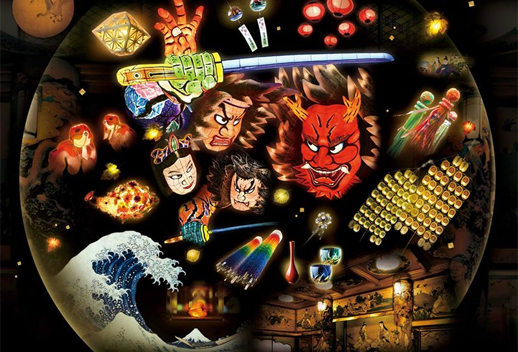10 Things in Tokyo: July Round-Up

Composer Erik Satie’s idiosyncrasies in life and work have raised him to a mythical status, apt for a man who refused to be pinned down by the simple term “musician.” His habits sound like something out of a Sophie Calle work – at one point he ate only white foods and bought seven identical shirts, one for each day of the week, so as to unburden himself of any unnecessary decision-making. Satie moved in all kinds of creative circles and was closely associated with the Dadaists, inspiring a whole generation of musical talent from Ravel to Poulenc and the minimalists. Bunkamura explores his broad-reaching career and relationship with the art world. (MuPon eligible).
Wildlife is out in force for contemporary artist Tsuyoshi Ozawa’s “Summer Project from the Director of the Elephant Kingdom” at Ichihara Lakeside Museum The famed elephant Yumeka of the neighboring “Ichihara Elephant Kingdom” guides visitors around Ozawa’s work, including his iconic futon mountain Everyone Likes Someone as You Like Someone and new the ‘Vegetable Weapon’ series made especially for this great animal, who dishes out tasks and homework not only for kids’ summer holidays but for all of us living in the world today. (MuPon).
With a line-up of greats such as Kenzo Tange, Arata Isozaki, Kiyonori Kikutake and Toyo Ito, “Legendary Houses in Postwar Japan – Provocative / Introspective” at Hachioji Yume Art Museum provides an overview of key residential architecture of the postwar period with a particular focus on the 1950 to 1970s, introducing the pioneering projects of 16 architects who have transformed our thinking towards living spaces.
The brooding works of Rey Camoy are brought together in a retrospective at Tokyo Station Gallery marking the 30th anniversary of his death, following the itinerant Japanese painter’s vision of a world inhabited by clowns, gamblers, drunks and various other social misfits. Contorted figures are depicted as enclosed in oppressive fields of shadow in a melancholy yet viscerally moving composition of disquietude. TABlog has a recent review of the exhibition here.
Journeys abound in an ambitious collection of 100 original watercolors from painter, picture book author, book designer and avid traveler Mitsumasa Anno at the Seiji Togo Museum through August 23. Inspired by his first travels to Europe in 1963, Anno would go on to pay tribute to landscapes of foreign lands that engraved themselves upon his mind in numerous works distilled with his sense of playful observation. (MuPon).
Ota Fine Arts continues its annual “Walk in Asia” exhibition with work from seven notable artists from across the region. Among the featured creators are Filipino Kiri Dalena, known for her ‘Erased Slogans’ in which all the statements on placards held by protestors in the early-1970s unrest have been removed from archival photographs Iranian Monir Farmanfarmaian recently presented a major museum review of her Iranian craft-inspired contemporary abstractions at New York’s Guggenheim. Yee Sookyung offers disturbingly bulbous forms constructed from rejected ceramics.
In “The Voice Behind Me,” Shiseido Gallery presents Hong Kong artist Lee Kit’s minimalist installations filled with a lingering sense of solitude and quiet emotion. Pastel greys combine with humble materials like fabrics, cardboard and mere shifts of light, seeming to breathe with the absence/presence of another. Resounding with poetry that leaves words hanging in the air only to elude the viewer attempting to place a finger upon them, this collection of work continues in the vein of Kit’s concern with the everyday human condition.
Cai Guo-Qiang brings his explosive power to the Yokohama Museum of Art in “There and Back Again”, his first major solo show in Japan in seven years. In a dynamic oeuvre encompassing gunpowder drawings, creative fireworks, land art and installation, Cai Guo-Qiang invests each piece with incisive intensity, embedding them in the historical materials of China. Witness the debut of new work and how it responds to the context of Yokohama, as well as Japan’s first showing of Head On, in all of its 99 leaps and crashes of fierce canine glory. (MuPon).
The sumptuously decorated rooms of Meguro’s Hyakudan Kaidan (Stairway of 100 Steps) are remarkable works of art in themselves further enriched this month in a spectacle of summertime illuminations adorning each space with the popular imagery of traditional lanterns, the giant light sculptures of the Aomori Nebuta Festival, and other radiant displays as part of Wa no Akari x Hyakudan Kaidan— 12 Japanese Illuminations at Meguro Gajoen.
Meiji studies of ornithology reveal the science of observation in drawings by 19th century painter Kakyo Kawabe at Intermediatheque’s “Aves Japonicae 2– Specimens on Paper”. Collated in a scroll, these scrupulous investigations into every claw and feather of the bird became reference specimens for other artists, providing insight into how painters approached nature over a century ago in their attempts to render living things precisely in vivid realism.
Emma Ota
Emma Ota


